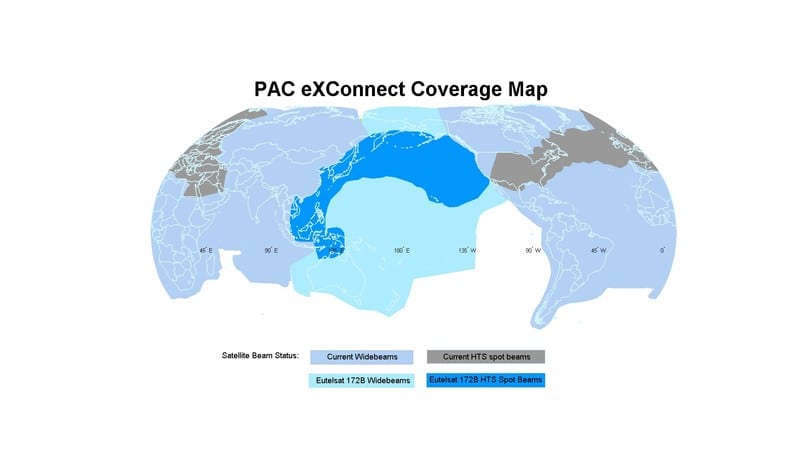
EUTELSAT 172B Coverage Map for Panasonic Avionics. Image courtesy of Panasonic Avionics
The latest Eutelsat 172B high throughput satellite, which launched in June, has officially entered into service. Now, Panasonic Avionics Corp. said it can deliver enhanced in-flight broadband connectivity, live television and mobile phone services to aircraft flying high traffic routes across the Asia-Pacific region spanning the West coast of North America to Asia, and down to Australia and the Pacific islands. Panasonic is layering the satellite’s capacity over key air traffic areas across its global satellite network, to ensure it can meet the growing connectivity demands of airlines and their passengers.
In addition to this support for airlines and their passengers, Panasonic subsidiary ITC Global will also benefit from the new satellite’s enhanced coverage provided through multiple widebeam footprints. ITC Global leverages the Panasonic broadband network to deliver connectivity to its energy, maritime and enterprise customers.
Maritime operators will now have improved coverage and availability across key Asia-Pacific shipping routes using the Eutelsat 172B satellite, with the faster data speeds enabling Asia’s continued growth in the global maritime sector. Oil and gas exploration customers across the region will also benefit from the new cost-effective high throughput satellite service for secure broadband networking to deliver more efficient operations and enhanced crew welfare solutions.
“Our service to the mobility market in Asia continues to grow exponentially. For the first time ever, airlines and passengers will reap the benefits of Ku-band HTS technology as they fly across the Pacific as well as up and down the coast of Asia into areas across Oceania,” said Hideo Nakano, CEO of Panasonic Avionics Corp. “We are very excited to add this significant improvement to our global network and look forward to unveiling the new passenger experience and operational efficiency capabilities that are only possible with this truly unique satellite.”
More than 1,800 aircraft flying routes all around the world use Panasonic’s global high-speed in-flight connectivity service. The company expects more than 10,000 aircraft to be connected to its global high-speed communications network by 2025.
Eutelsat 172B HTS uses a multi-port amplifier, which allows power to be dynamically moved among the HTS beams to meet demand. This ability for the HTS beams to “follow” aircraft and other mobile users enables Panasonic to better meet customer demand and cost-effectively ensure consistently high levels of service in a way that other service providers cannot match.
“Eutelsat 172B’s entry into service is a milestone in the journey we’ve traveled with Panasonic since they shared with us their roadmap of connectivity requirements in Asia-Pacific,” said Rodolphe Belmer, Eutelsat CEO. “We’re proud to see our all-electric satellite get to work for a major client, delivering uniquely-designed capacity for in-flight and maritime connectivity and also ready to serve corporate network, cellular backhaul, video and government markets. From its strategic location at 172 degrees east, Eutelsat 172B is now open for business over land and sea from Alaska to Australia.”
The entry into service of Eutelsat 172B coincides with the introduction of Panasonic’s new BC-03 modem, developed in conjunction with Newtec, which also caters for future demand by supporting speeds of up to 250 Mbps to aircraft. This includes three demodulators for seamless beam switching and simultaneous data and video reception.
This item was originally published by Via Satellite, an Avionics sister publication. It has been edited.